
Question Number 14157 by b.e.h.i.8.3.4.1.7@gmail.com last updated on 29/May/17

Commented by ajfour last updated on 30/May/17

$${kindly}\:{view}\:{my}\:{solution}\:{in} \\ $$$${Q}.\mathrm{14306}\:{solved}\:{by}\:{coordinate} \\ $$$${geometry}.. \\ $$
Commented by RasheedSindhi last updated on 31/May/17
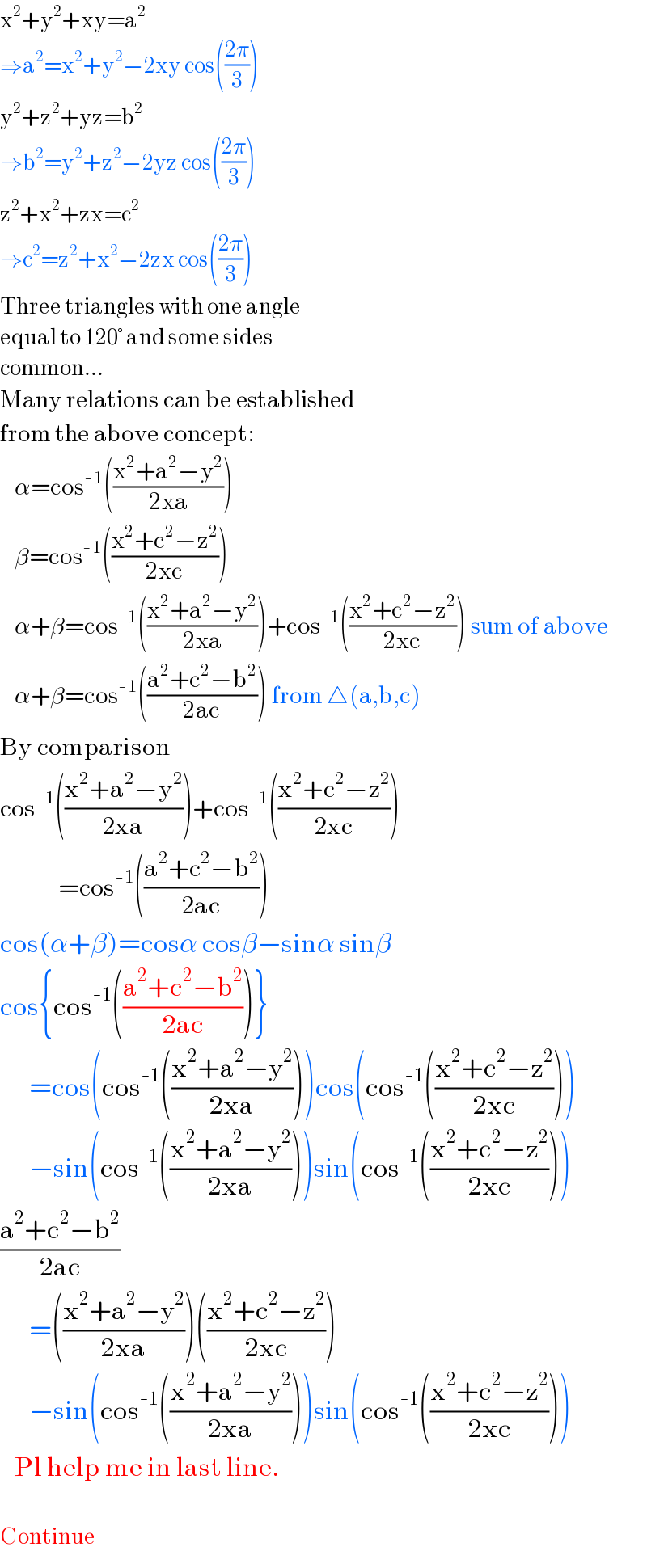
$$\mathrm{x}^{\mathrm{2}} +\mathrm{y}^{\mathrm{2}} +\mathrm{xy}=\mathrm{a}^{\mathrm{2}} \\ $$$$\Rightarrow\mathrm{a}^{\mathrm{2}} =\mathrm{x}^{\mathrm{2}} +\mathrm{y}^{\mathrm{2}} −\mathrm{2xy}\:\mathrm{cos}\left(\frac{\mathrm{2}\pi}{\mathrm{3}}\right) \\ $$$$\mathrm{y}^{\mathrm{2}} +\mathrm{z}^{\mathrm{2}} +\mathrm{yz}=\mathrm{b}^{\mathrm{2}} \\ $$$$\Rightarrow\mathrm{b}^{\mathrm{2}} =\mathrm{y}^{\mathrm{2}} +\mathrm{z}^{\mathrm{2}} −\mathrm{2yz}\:\mathrm{cos}\left(\frac{\mathrm{2}\pi}{\mathrm{3}}\right)\: \\ $$$$\mathrm{z}^{\mathrm{2}} +\mathrm{x}^{\mathrm{2}} +\mathrm{zx}=\mathrm{c}^{\mathrm{2}} \\ $$$$\Rightarrow\mathrm{c}^{\mathrm{2}} =\mathrm{z}^{\mathrm{2}} +\mathrm{x}^{\mathrm{2}} −\mathrm{2zx}\:\mathrm{cos}\left(\frac{\mathrm{2}\pi}{\mathrm{3}}\right)\: \\ $$$$\mathrm{Three}\:\mathrm{triangles}\:\mathrm{with}\:\mathrm{one}\:\mathrm{angle} \\ $$$$\mathrm{equal}\:\mathrm{to}\:\mathrm{120}°\:\mathrm{and}\:\mathrm{some}\:\mathrm{sides} \\ $$$$\mathrm{common}... \\ $$$$\mathrm{Many}\:\mathrm{relations}\:\mathrm{can}\:\mathrm{be}\:\mathrm{established} \\ $$$$\mathrm{from}\:\mathrm{the}\:\mathrm{above}\:\mathrm{concept}: \\ $$$$\:\:\:\alpha=\mathrm{cos}^{-\mathrm{1}} \left(\frac{\mathrm{x}^{\mathrm{2}} +\mathrm{a}^{\mathrm{2}} −\mathrm{y}^{\mathrm{2}} }{\mathrm{2xa}}\right) \\ $$$$\:\:\:\beta=\mathrm{cos}^{-\mathrm{1}} \left(\frac{\mathrm{x}^{\mathrm{2}} +\mathrm{c}^{\mathrm{2}} −\mathrm{z}^{\mathrm{2}} }{\mathrm{2xc}}\right) \\ $$$$\:\:\:\alpha+\beta=\mathrm{cos}^{-\mathrm{1}} \left(\frac{\mathrm{x}^{\mathrm{2}} +\mathrm{a}^{\mathrm{2}} −\mathrm{y}^{\mathrm{2}} }{\mathrm{2xa}}\right)+\mathrm{cos}^{-\mathrm{1}} \left(\frac{\mathrm{x}^{\mathrm{2}} +\mathrm{c}^{\mathrm{2}} −\mathrm{z}^{\mathrm{2}} }{\mathrm{2xc}}\right)\:\mathrm{sum}\:\mathrm{of}\:\mathrm{above} \\ $$$$\:\:\:\alpha+\beta=\mathrm{cos}^{-\mathrm{1}} \left(\frac{\mathrm{a}^{\mathrm{2}} +\mathrm{c}^{\mathrm{2}} −\mathrm{b}^{\mathrm{2}} }{\mathrm{2ac}}\right)\:\mathrm{from}\:\bigtriangleup\left(\mathrm{a},\mathrm{b},\mathrm{c}\right) \\ $$$$\mathrm{By}\:\mathrm{comparison} \\ $$$$\mathrm{cos}^{-\mathrm{1}} \left(\frac{\mathrm{x}^{\mathrm{2}} +\mathrm{a}^{\mathrm{2}} −\mathrm{y}^{\mathrm{2}} }{\mathrm{2xa}}\right)+\mathrm{cos}^{-\mathrm{1}} \left(\frac{\mathrm{x}^{\mathrm{2}} +\mathrm{c}^{\mathrm{2}} −\mathrm{z}^{\mathrm{2}} }{\mathrm{2xc}}\right) \\ $$$$\:\:\:\:\:\:\:\:\:\:\:\:=\mathrm{cos}^{-\mathrm{1}} \left(\frac{\mathrm{a}^{\mathrm{2}} +\mathrm{c}^{\mathrm{2}} −\mathrm{b}^{\mathrm{2}} }{\mathrm{2ac}}\right) \\ $$$$\mathrm{cos}\left(\alpha+\beta\right)=\mathrm{cos}\alpha\:\mathrm{cos}\beta−\mathrm{sin}\alpha\:\mathrm{sin}\beta\: \\ $$$$\mathrm{cos}\left\{\mathrm{cos}^{-\mathrm{1}} \left(\frac{\mathrm{a}^{\mathrm{2}} +\mathrm{c}^{\mathrm{2}} −\mathrm{b}^{\mathrm{2}} }{\mathrm{2ac}}\right)\right\} \\ $$$$\:\:\:\:\:\:=\mathrm{cos}\left(\mathrm{cos}^{-\mathrm{1}} \left(\frac{\mathrm{x}^{\mathrm{2}} +\mathrm{a}^{\mathrm{2}} −\mathrm{y}^{\mathrm{2}} }{\mathrm{2xa}}\right)\right)\mathrm{cos}\left(\mathrm{cos}^{-\mathrm{1}} \left(\frac{\mathrm{x}^{\mathrm{2}} +\mathrm{c}^{\mathrm{2}} −\mathrm{z}^{\mathrm{2}} }{\mathrm{2xc}}\right)\right) \\ $$$$\:\:\:\:\:\:−\mathrm{sin}\left(\mathrm{cos}^{-\mathrm{1}} \left(\frac{\mathrm{x}^{\mathrm{2}} +\mathrm{a}^{\mathrm{2}} −\mathrm{y}^{\mathrm{2}} }{\mathrm{2xa}}\right)\right)\mathrm{sin}\left(\mathrm{cos}^{-\mathrm{1}} \left(\frac{\mathrm{x}^{\mathrm{2}} +\mathrm{c}^{\mathrm{2}} −\mathrm{z}^{\mathrm{2}} }{\mathrm{2xc}}\right)\right) \\ $$$$\frac{\mathrm{a}^{\mathrm{2}} +\mathrm{c}^{\mathrm{2}} −\mathrm{b}^{\mathrm{2}} }{\mathrm{2ac}} \\ $$$$\:\:\:\:\:\:=\left(\frac{\mathrm{x}^{\mathrm{2}} +\mathrm{a}^{\mathrm{2}} −\mathrm{y}^{\mathrm{2}} }{\mathrm{2xa}}\right)\left(\frac{\mathrm{x}^{\mathrm{2}} +\mathrm{c}^{\mathrm{2}} −\mathrm{z}^{\mathrm{2}} }{\mathrm{2xc}}\right) \\ $$$$\:\:\:\:\:\:−\mathrm{sin}\left(\mathrm{cos}^{-\mathrm{1}} \left(\frac{\mathrm{x}^{\mathrm{2}} +\mathrm{a}^{\mathrm{2}} −\mathrm{y}^{\mathrm{2}} }{\mathrm{2xa}}\right)\right)\mathrm{sin}\left(\mathrm{cos}^{-\mathrm{1}} \left(\frac{\mathrm{x}^{\mathrm{2}} +\mathrm{c}^{\mathrm{2}} −\mathrm{z}^{\mathrm{2}} }{\mathrm{2xc}}\right)\right) \\ $$$$\:\:\:\mathrm{Pl}\:\mathrm{help}\:\mathrm{me}\:\mathrm{in}\:\mathrm{last}\:\mathrm{line}. \\ $$$$ \\ $$$$\mathrm{Continue} \\ $$
Commented by RasheedSindhi last updated on 30/May/17

Commented by mrW1 last updated on 30/May/17

$${This}\:{is}\:{great}!\:{It}\:{shows}\:{the}\:{condition} \\ $$$${when}\:{solution}\:{exists}: \\ $$$${if}\:{a}^{\mathrm{2}} ,\:{b}^{\mathrm{2}} \:{and}\:{c}^{\mathrm{2}} \:{can}\:{form}\:{a}\:{triangle}, \\ $$$${there}\:{is}\:{a}\:{solution}! \\ $$
Commented by prakash jain last updated on 30/May/17

$$\mathrm{A}\:\mathrm{solution}\:\mathrm{will}\:\mathrm{always}\:\mathrm{exist}\:\mathrm{since} \\ $$$$\mathrm{it}\:\mathrm{is}\:\mathrm{reducible}\:\mathrm{to}\:\mathrm{quadratic}. \\ $$
Commented by b.e.h.i.8.3.4.1.7@gmail.com last updated on 30/May/17

$${dear}\:{mrW}\mathrm{1}!\:{way}\:{a}^{\mathrm{2}} ,{b}^{\mathrm{2}} ,{c}^{\mathrm{2}} ?{way}\:{not}\::{a},{b},{c}? \\ $$
Commented by RasheedSindhi last updated on 30/May/17

$$\mathrm{Actually}\:\mathrm{my}\:\mathrm{first}\:\mathrm{figure}\:\mathrm{was} \\ $$$$\mathrm{somewhat}\:\mathrm{wrong}!\:\mathrm{And}\:\mathrm{mrW1} \\ $$$$\mathrm{commented}\:\mathrm{on}\:\mathrm{that}\:\mathrm{picture}. \\ $$
Commented by mrW1 last updated on 30/May/17

$${to}\:{prakash}: \\ $$$${that}'{s}\:{what}\:{I}\:{wonder}.\:\mathrm{2}\:{cylinders}\:{always} \\ $$$${have}\:\mathrm{2}\:{intersection}\:{lines}\:\left({curves}\right). \\ $$$${but}\:{the}\:{third}\:{cylinder}\:{doesn}'{t}\:{always} \\ $$$${intersect}\:{these}\:\mathrm{2}\:{lines}.\:{for}\:{example} \\ $$$${if}\:{c}\:{is}\:{very}\:{small}\:{or}\:{very}\:{big}\:{in}\:{relation} \\ $$$${to}\:{a}\:{and}\:{b},\:{see}\:{case}\:\mathrm{1}\:{and}\:\mathrm{3}\:{in}\:{picture}. \\ $$
Commented by mrW1 last updated on 30/May/17

Commented by Tawa11 last updated on 15/Jan/22

$$\mathrm{Nice}\:\mathrm{one}\:\mathrm{sirs}. \\ $$
Commented by prakash jain last updated on 15/Jan/22

$$\mathrm{Great}\:\mathrm{to}\:\mathrm{hear}\:\mathrm{from}\:\mathrm{you}\:\mathrm{Tawa}. \\ $$$$\mathrm{Long}\:\mathrm{time}\:\mathrm{since}\:\mathrm{we}\:\mathrm{worked}\:\mathrm{these} \\ $$$$\mathrm{questions} \\ $$
Answered by RasheedSindhi last updated on 30/May/17
![x^2 +y^2 +xy=a^2 ................(i) y^2 +z^2 +yz=b^2 ................(ii) z^2 +x^2 +zx=c^2 ................(iii) (i)−(ii): x^2 −z^2 +xy−yz=a^2 −b^2 (x−z)(x+z)+y(x−z)=a^2 −b^2 (x−z)(x+y+z)=a^2 −b^2 ......(iv) (iii)−(ii): x^2 −y^2 +xz−yz=c^2 −b^2 (x−y)(x+y)+z(x−y)=c^2 −b^2 (x−y)(x+y+z)=c^2 −b^2 .......(v) (v)/(iv): ((x−y)/(x−z))=((c^2 −b^2 )/(a^2 −b^2 )) x−y=((c^2 −b^2 )/(a^2 −b^2 ))(x−z) x−((c^2 −b^2 )/(a^2 −b^2 ))x=y−((c^2 −b^2 )/(a^2 −b^2 ))z x(1−((c^2 −b^2 )/(a^2 −b^2 )))=y−((c^2 −b^2 )/(a^2 −b^2 ))z x(((a^2 −b^2 −c^2 +b^2 )/(a^2 −b^2 )))=((y(a^2 −b^2 )−z(c^2 −b^2 ))/(a^2 −b^2 )) x(a^2 −c^2 )=y(a^2 −b^2 )−z(c^2 −b^2 ) x=((y(a^2 −b^2 )−z(c^2 −b^2 ))/(a^2 −c^2 )) Substituting in (v) [or in(iv)] (((y(a^2 −b^2 )−z(c^2 −b^2 ))/(a^2 −c^2 ))−y)(((y(a^2 −b^2 )−z(c^2 −b^2 ))/(a^2 −c^2 ))+y+z)=c^2 −b^2 (((y(a^2 −b^2 )−z(c^2 −b^2 )−y(a^2 −c^2 ))/(a^2 −c^2 )))(((y(a^2 −b^2 )−z(c^2 −b^2 )+y(a^2 −c^2 )+z(a^2 −c^2 ))/(a^2 −c^2 )))=c^2 −b^2 {y(c^2 −b^2 )−z(c^2 −b^2 )}{y(2a^2 −b^2 −c^2 )+z(a^2 +b^2 −2c^2 }=(c^2 −b^2 )(a^2 −c^2 )^2 (c^2 −b^2 )(y−z){y(2a^2 −b^2 −c^2 )+z(a^2 +b^2 −2c^2 }−(c^2 −b^2 )(a^2 −c^2 )^2 =0 (c^2 −b^2 ){(y−z){y(2a^2 −b^2 −c^2 )+z(a^2 +b^2 −2c^2 }−(a^2 −c^2 )^2 }=0 (c^2 −b^2 )=0∣{(y−z){y(2a^2 −b^2 −c^2 )+z(a^2 +b^2 −2c^2 }−(a^2 −c^2 )^2 }=0 b=c ∣(y−z){y(2a^2 −b^2 −c^2 )+z(a^2 +b^2 −2c^2 }−(a^2 −c^2 )^2 =0 (y−z){y(2a^2 −b^2 −c^2 )+z(a^2 +b^2 −2c^2 }=(a^2 −c^2 )^2 From (ii) y^2 +yz+z^2 −b^2 =0 y=((−z±(√(z^2 −4(z^2 −b^2 ))))/2) (((−z±(√(z^2 −4(z^2 −b^2 ))))/2)−z){(((−z±(√(z^2 −4(z^2 −b^2 ))))/2))(2a^2 −b^2 −c^2 )+z(a^2 +b^2 −2c^2 )}=(a^2 −c^2 )^2 (((−z±(√(z^2 −4(z^2 −b^2 )))−2z)/2)){(((−z±(√(z^2 −4(z^2 −b^2 ))))/2))(2a^2 −b^2 −c^2 )+z(a^2 +b^2 −2c^2 )}=(a^2 −c^2 )^2 Too complicated to solve for z](Q14182.png)
$$\mathrm{x}^{\mathrm{2}} +\mathrm{y}^{\mathrm{2}} +\mathrm{xy}=\mathrm{a}^{\mathrm{2}} ................\left(\mathrm{i}\right) \\ $$$$\mathrm{y}^{\mathrm{2}} +\mathrm{z}^{\mathrm{2}} +\mathrm{yz}=\mathrm{b}^{\mathrm{2}} ................\left(\mathrm{ii}\right) \\ $$$$\mathrm{z}^{\mathrm{2}} +\mathrm{x}^{\mathrm{2}} +\mathrm{zx}=\mathrm{c}^{\mathrm{2}} ................\left(\mathrm{iii}\right) \\ $$$$\left(\mathrm{i}\right)−\left(\mathrm{ii}\right): \\ $$$$\mathrm{x}^{\mathrm{2}} −\mathrm{z}^{\mathrm{2}} +\mathrm{xy}−\mathrm{yz}=\mathrm{a}^{\mathrm{2}} −\mathrm{b}^{\mathrm{2}} \\ $$$$\left(\mathrm{x}−\mathrm{z}\right)\left(\mathrm{x}+\mathrm{z}\right)+\mathrm{y}\left(\mathrm{x}−\mathrm{z}\right)=\mathrm{a}^{\mathrm{2}} −\mathrm{b}^{\mathrm{2}} \\ $$$$\left(\mathrm{x}−\mathrm{z}\right)\left(\mathrm{x}+\mathrm{y}+\mathrm{z}\right)=\mathrm{a}^{\mathrm{2}} −\mathrm{b}^{\mathrm{2}} ......\left(\mathrm{iv}\right) \\ $$$$\left(\mathrm{iii}\right)−\left(\mathrm{ii}\right): \\ $$$$\mathrm{x}^{\mathrm{2}} −\mathrm{y}^{\mathrm{2}} +\mathrm{xz}−\mathrm{yz}=\mathrm{c}^{\mathrm{2}} −\mathrm{b}^{\mathrm{2}} \\ $$$$\left(\mathrm{x}−\mathrm{y}\right)\left(\mathrm{x}+\mathrm{y}\right)+\mathrm{z}\left(\mathrm{x}−\mathrm{y}\right)=\mathrm{c}^{\mathrm{2}} −\mathrm{b}^{\mathrm{2}} \\ $$$$\left(\mathrm{x}−\mathrm{y}\right)\left(\mathrm{x}+\mathrm{y}+\mathrm{z}\right)=\mathrm{c}^{\mathrm{2}} −\mathrm{b}^{\mathrm{2}} .......\left(\mathrm{v}\right) \\ $$$$\left(\mathrm{v}\right)/\left(\mathrm{iv}\right): \\ $$$$\frac{\mathrm{x}−\mathrm{y}}{\mathrm{x}−\mathrm{z}}=\frac{\mathrm{c}^{\mathrm{2}} −\mathrm{b}^{\mathrm{2}} }{\mathrm{a}^{\mathrm{2}} −\mathrm{b}^{\mathrm{2}} } \\ $$$$\mathrm{x}−\mathrm{y}=\frac{\mathrm{c}^{\mathrm{2}} −\mathrm{b}^{\mathrm{2}} }{\mathrm{a}^{\mathrm{2}} −\mathrm{b}^{\mathrm{2}} }\left(\mathrm{x}−\mathrm{z}\right) \\ $$$$\mathrm{x}−\frac{\mathrm{c}^{\mathrm{2}} −\mathrm{b}^{\mathrm{2}} }{\mathrm{a}^{\mathrm{2}} −\mathrm{b}^{\mathrm{2}} }\mathrm{x}=\mathrm{y}−\frac{\mathrm{c}^{\mathrm{2}} −\mathrm{b}^{\mathrm{2}} }{\mathrm{a}^{\mathrm{2}} −\mathrm{b}^{\mathrm{2}} }\mathrm{z} \\ $$$$\mathrm{x}\left(\mathrm{1}−\frac{\mathrm{c}^{\mathrm{2}} −\mathrm{b}^{\mathrm{2}} }{\mathrm{a}^{\mathrm{2}} −\mathrm{b}^{\mathrm{2}} }\right)=\mathrm{y}−\frac{\mathrm{c}^{\mathrm{2}} −\mathrm{b}^{\mathrm{2}} }{\mathrm{a}^{\mathrm{2}} −\mathrm{b}^{\mathrm{2}} }\mathrm{z} \\ $$$$\mathrm{x}\left(\frac{\mathrm{a}^{\mathrm{2}} −\mathrm{b}^{\mathrm{2}} −\mathrm{c}^{\mathrm{2}} +\mathrm{b}^{\mathrm{2}} }{\mathrm{a}^{\mathrm{2}} −\mathrm{b}^{\mathrm{2}} }\right)=\frac{\mathrm{y}\left(\mathrm{a}^{\mathrm{2}} −\mathrm{b}^{\mathrm{2}} \right)−\mathrm{z}\left(\mathrm{c}^{\mathrm{2}} −\mathrm{b}^{\mathrm{2}} \right)}{\mathrm{a}^{\mathrm{2}} −\mathrm{b}^{\mathrm{2}} } \\ $$$$\mathrm{x}\left(\mathrm{a}^{\mathrm{2}} −\mathrm{c}^{\mathrm{2}} \right)=\mathrm{y}\left(\mathrm{a}^{\mathrm{2}} −\mathrm{b}^{\mathrm{2}} \right)−\mathrm{z}\left(\mathrm{c}^{\mathrm{2}} −\mathrm{b}^{\mathrm{2}} \right) \\ $$$$\mathrm{x}=\frac{\mathrm{y}\left(\mathrm{a}^{\mathrm{2}} −\mathrm{b}^{\mathrm{2}} \right)−\mathrm{z}\left(\mathrm{c}^{\mathrm{2}} −\mathrm{b}^{\mathrm{2}} \right)}{\mathrm{a}^{\mathrm{2}} −\mathrm{c}^{\mathrm{2}} } \\ $$$$\mathrm{Substituting}\:\mathrm{in}\:\left(\mathrm{v}\right)\:\left[\mathrm{or}\:\mathrm{in}\left(\mathrm{iv}\right)\right] \\ $$$$\left(\frac{\mathrm{y}\left(\mathrm{a}^{\mathrm{2}} −\mathrm{b}^{\mathrm{2}} \right)−\mathrm{z}\left(\mathrm{c}^{\mathrm{2}} −\mathrm{b}^{\mathrm{2}} \right)}{\mathrm{a}^{\mathrm{2}} −\mathrm{c}^{\mathrm{2}} }−\mathrm{y}\right)\left(\frac{\mathrm{y}\left(\mathrm{a}^{\mathrm{2}} −\mathrm{b}^{\mathrm{2}} \right)−\mathrm{z}\left(\mathrm{c}^{\mathrm{2}} −\mathrm{b}^{\mathrm{2}} \right)}{\mathrm{a}^{\mathrm{2}} −\mathrm{c}^{\mathrm{2}} }+\mathrm{y}+\mathrm{z}\right)=\mathrm{c}^{\mathrm{2}} −\mathrm{b}^{\mathrm{2}} \\ $$$$\left(\frac{\mathrm{y}\left(\mathrm{a}^{\mathrm{2}} −\mathrm{b}^{\mathrm{2}} \right)−\mathrm{z}\left(\mathrm{c}^{\mathrm{2}} −\mathrm{b}^{\mathrm{2}} \right)−\mathrm{y}\left(\mathrm{a}^{\mathrm{2}} −\mathrm{c}^{\mathrm{2}} \right)}{\mathrm{a}^{\mathrm{2}} −\mathrm{c}^{\mathrm{2}} }\right)\left(\frac{\mathrm{y}\left(\mathrm{a}^{\mathrm{2}} −\mathrm{b}^{\mathrm{2}} \right)−\mathrm{z}\left(\mathrm{c}^{\mathrm{2}} −\mathrm{b}^{\mathrm{2}} \right)+\mathrm{y}\left(\mathrm{a}^{\mathrm{2}} −\mathrm{c}^{\mathrm{2}} \right)+\mathrm{z}\left(\mathrm{a}^{\mathrm{2}} −\mathrm{c}^{\mathrm{2}} \right)}{\mathrm{a}^{\mathrm{2}} −\mathrm{c}^{\mathrm{2}} }\right)=\mathrm{c}^{\mathrm{2}} −\mathrm{b}^{\mathrm{2}} \\ $$$$\left\{\mathrm{y}\left(\mathrm{c}^{\mathrm{2}} −\mathrm{b}^{\mathrm{2}} \right)−\mathrm{z}\left(\mathrm{c}^{\mathrm{2}} −\mathrm{b}^{\mathrm{2}} \right)\right\}\left\{\mathrm{y}\left(\mathrm{2a}^{\mathrm{2}} −\mathrm{b}^{\mathrm{2}} −\mathrm{c}^{\mathrm{2}} \right)+\mathrm{z}\left(\mathrm{a}^{\mathrm{2}} +\mathrm{b}^{\mathrm{2}} −\mathrm{2c}^{\mathrm{2}} \right\}=\left(\mathrm{c}^{\mathrm{2}} −\mathrm{b}^{\mathrm{2}} \right)\left(\mathrm{a}^{\mathrm{2}} −\mathrm{c}^{\mathrm{2}} \right)^{\mathrm{2}} \right. \\ $$$$\left(\mathrm{c}^{\mathrm{2}} −\mathrm{b}^{\mathrm{2}} \right)\left(\mathrm{y}−\mathrm{z}\right)\left\{\mathrm{y}\left(\mathrm{2a}^{\mathrm{2}} −\mathrm{b}^{\mathrm{2}} −\mathrm{c}^{\mathrm{2}} \right)+\mathrm{z}\left(\mathrm{a}^{\mathrm{2}} +\mathrm{b}^{\mathrm{2}} −\mathrm{2c}^{\mathrm{2}} \right\}−\left(\mathrm{c}^{\mathrm{2}} −\mathrm{b}^{\mathrm{2}} \right)\left(\mathrm{a}^{\mathrm{2}} −\mathrm{c}^{\mathrm{2}} \right)^{\mathrm{2}} =\mathrm{0}\right. \\ $$$$\left(\mathrm{c}^{\mathrm{2}} −\mathrm{b}^{\mathrm{2}} \right)\left\{\left(\mathrm{y}−\mathrm{z}\right)\left\{\mathrm{y}\left(\mathrm{2a}^{\mathrm{2}} −\mathrm{b}^{\mathrm{2}} −\mathrm{c}^{\mathrm{2}} \right)+\mathrm{z}\left(\mathrm{a}^{\mathrm{2}} +\mathrm{b}^{\mathrm{2}} −\mathrm{2c}^{\mathrm{2}} \right\}−\left(\mathrm{a}^{\mathrm{2}} −\mathrm{c}^{\mathrm{2}} \right)^{\mathrm{2}} \right\}=\mathrm{0}\right. \\ $$$$\left(\mathrm{c}^{\mathrm{2}} −\mathrm{b}^{\mathrm{2}} \right)=\mathrm{0}\mid\left\{\left(\mathrm{y}−\mathrm{z}\right)\left\{\mathrm{y}\left(\mathrm{2a}^{\mathrm{2}} −\mathrm{b}^{\mathrm{2}} −\mathrm{c}^{\mathrm{2}} \right)+\mathrm{z}\left(\mathrm{a}^{\mathrm{2}} +\mathrm{b}^{\mathrm{2}} −\mathrm{2c}^{\mathrm{2}} \right\}−\left(\mathrm{a}^{\mathrm{2}} −\mathrm{c}^{\mathrm{2}} \right)^{\mathrm{2}} \right\}=\mathrm{0}\right. \\ $$$$\mathrm{b}=\mathrm{c}\:\mid\left(\mathrm{y}−\mathrm{z}\right)\left\{\mathrm{y}\left(\mathrm{2a}^{\mathrm{2}} −\mathrm{b}^{\mathrm{2}} −\mathrm{c}^{\mathrm{2}} \right)+\mathrm{z}\left(\mathrm{a}^{\mathrm{2}} +\mathrm{b}^{\mathrm{2}} −\mathrm{2c}^{\mathrm{2}} \right\}−\left(\mathrm{a}^{\mathrm{2}} −\mathrm{c}^{\mathrm{2}} \right)^{\mathrm{2}} =\mathrm{0}\right. \\ $$$$\left(\mathrm{y}−\mathrm{z}\right)\left\{\mathrm{y}\left(\mathrm{2a}^{\mathrm{2}} −\mathrm{b}^{\mathrm{2}} −\mathrm{c}^{\mathrm{2}} \right)+\mathrm{z}\left(\mathrm{a}^{\mathrm{2}} +\mathrm{b}^{\mathrm{2}} −\mathrm{2c}^{\mathrm{2}} \right\}=\left(\mathrm{a}^{\mathrm{2}} −\mathrm{c}^{\mathrm{2}} \right)^{\mathrm{2}} \right. \\ $$$$\mathrm{From}\:\left(\mathrm{ii}\right)\:\mathrm{y}^{\mathrm{2}} +\mathrm{yz}+\mathrm{z}^{\mathrm{2}} −\mathrm{b}^{\mathrm{2}} =\mathrm{0} \\ $$$$\mathrm{y}=\frac{−\mathrm{z}\pm\sqrt{\mathrm{z}^{\mathrm{2}} −\mathrm{4}\left(\mathrm{z}^{\mathrm{2}} −\mathrm{b}^{\mathrm{2}} \right)}}{\mathrm{2}} \\ $$$$\left(\frac{−\mathrm{z}\pm\sqrt{\mathrm{z}^{\mathrm{2}} −\mathrm{4}\left(\mathrm{z}^{\mathrm{2}} −\mathrm{b}^{\mathrm{2}} \right)}}{\mathrm{2}}−\mathrm{z}\right)\left\{\left(\frac{−\mathrm{z}\pm\sqrt{\mathrm{z}^{\mathrm{2}} −\mathrm{4}\left(\mathrm{z}^{\mathrm{2}} −\mathrm{b}^{\mathrm{2}} \right)}}{\mathrm{2}}\right)\left(\mathrm{2a}^{\mathrm{2}} −\mathrm{b}^{\mathrm{2}} −\mathrm{c}^{\mathrm{2}} \right)+\mathrm{z}\left(\mathrm{a}^{\mathrm{2}} +\mathrm{b}^{\mathrm{2}} −\mathrm{2c}^{\mathrm{2}} \right)\right\}=\left(\mathrm{a}^{\mathrm{2}} −\mathrm{c}^{\mathrm{2}} \right)^{\mathrm{2}} \\ $$$$\left(\frac{−\mathrm{z}\pm\sqrt{\mathrm{z}^{\mathrm{2}} −\mathrm{4}\left(\mathrm{z}^{\mathrm{2}} −\mathrm{b}^{\mathrm{2}} \right)}−\mathrm{2z}}{\mathrm{2}}\right)\left\{\left(\frac{−\mathrm{z}\pm\sqrt{\mathrm{z}^{\mathrm{2}} −\mathrm{4}\left(\mathrm{z}^{\mathrm{2}} −\mathrm{b}^{\mathrm{2}} \right)}}{\mathrm{2}}\right)\left(\mathrm{2a}^{\mathrm{2}} −\mathrm{b}^{\mathrm{2}} −\mathrm{c}^{\mathrm{2}} \right)+\mathrm{z}\left(\mathrm{a}^{\mathrm{2}} +\mathrm{b}^{\mathrm{2}} −\mathrm{2c}^{\mathrm{2}} \right)\right\}=\left(\mathrm{a}^{\mathrm{2}} −\mathrm{c}^{\mathrm{2}} \right)^{\mathrm{2}} \\ $$$$\mathrm{Too}\:\mathrm{complicated}\:\mathrm{to}\:\mathrm{solve}\:\mathrm{for}\:\mathrm{z} \\ $$$$ \\ $$
Commented by b.e.h.i.8.3.4.1.7@gmail.com last updated on 29/May/17

$${hello}\:{mr}\:{Rasheed}.{thank}\:{you}\:{so}\:{much}. \\ $$$${but}\:{i}\:{need}\:{final}\:{answers}. \\ $$
Commented by ajfour last updated on 30/May/17

$${Sir},\:{kindly}\:{see}\:{my}\:{view}\:{to}\:{the}\:{solution} \\ $$$${of}\:{this}\:{question}\:{in}\:{Q}.\mathrm{14306}. \\ $$
Commented by RasheedSindhi last updated on 29/May/17

$$\intercal\mathrm{hank}\:\mathrm{you}\:\mathrm{behi},\mathrm{I}\:\mathrm{am}\:\mathrm{trying}\:\mathrm{of} \\ $$$$\mathrm{my}\:\mathrm{best}! \\ $$
Commented by prakash jain last updated on 29/May/17
![((x−y)/(x−z))=((c^2 −b^2 )/(a^2 −b^2 )) x(a^2 −b^2 −c^2 +b^2 )=y(a^2 −b^2 )+z(b^2 −c^2 ) x(a^2 −c^2 )=y(a^2 −b^2 )+z(b^2 −c^2 ) (i) y=kx,z=lx (a^2 −c^2 )=k(a^2 −b^2 )+l(b^2 −c^2 ) ⇒l=((a^2 −c^2 )/(b^2 −c^2 ))+((a^2 −b^2 )/(b^2 −c^2 ))k (i) x^2 (k^2 +k+1)=a^2 x^2 (k^2 +kl+1)=b^2 x^2 (l^2 +l+1)=c^2 ((k^2 +k+1)/(l^2 +l+1))=(a^2 /c^2 ) subtituting value of l from (i) (c^2 /a^2 )(k^2 +k+1)=[((a^2 −c^2 )/(b^2 −c^2 ))+((a^2 −b^2 )/(b^2 −c^2 ))k]^2 +[((a^2 −c^2 )/(b^2 −c^2 ))+((a^2 −b^2 )/(b^2 −c^2 ))k]+1 now we get a quadratic in k. a^2 −c^2 =u a^2 −b^2 =v ((a^2 −u)/a^2 )(k^2 +k+1)=[(u/(u−v))+(v/(u−v))k]^2 +[(u/(u−v))+(v/(u−v))k]+1 (1/a^2 )(u−v)^2 (a^2 −u)(k^2 +k+1) =(u+vk)^2 +(u−v)(u+vk)+(u−v)^2 It is a quadratic but not a simple answer. once we get k we can compute l and x.](Q14192.png)
$$\frac{{x}−{y}}{{x}−{z}}=\frac{{c}^{\mathrm{2}} −{b}^{\mathrm{2}} }{{a}^{\mathrm{2}} −{b}^{\mathrm{2}} } \\ $$$${x}\left({a}^{\mathrm{2}} −{b}^{\mathrm{2}} −{c}^{\mathrm{2}} +{b}^{\mathrm{2}} \right)={y}\left({a}^{\mathrm{2}} −{b}^{\mathrm{2}} \right)+{z}\left({b}^{\mathrm{2}} −{c}^{\mathrm{2}} \right) \\ $$$${x}\left({a}^{\mathrm{2}} −{c}^{\mathrm{2}} \right)={y}\left({a}^{\mathrm{2}} −{b}^{\mathrm{2}} \right)+{z}\left({b}^{\mathrm{2}} −{c}^{\mathrm{2}} \right)\:\:\left({i}\right) \\ $$$${y}={kx},{z}={lx} \\ $$$$\left({a}^{\mathrm{2}} −{c}^{\mathrm{2}} \right)={k}\left({a}^{\mathrm{2}} −{b}^{\mathrm{2}} \right)+{l}\left({b}^{\mathrm{2}} −{c}^{\mathrm{2}} \right) \\ $$$$\Rightarrow{l}=\frac{{a}^{\mathrm{2}} −{c}^{\mathrm{2}} }{{b}^{\mathrm{2}} −{c}^{\mathrm{2}} }+\frac{{a}^{\mathrm{2}} −{b}^{\mathrm{2}} }{{b}^{\mathrm{2}} −{c}^{\mathrm{2}} }{k}\:\:\:\:\left({i}\right) \\ $$$${x}^{\mathrm{2}} \left({k}^{\mathrm{2}} +{k}+\mathrm{1}\right)={a}^{\mathrm{2}} \\ $$$${x}^{\mathrm{2}} \left({k}^{\mathrm{2}} +{kl}+\mathrm{1}\right)={b}^{\mathrm{2}} \\ $$$${x}^{\mathrm{2}} \left({l}^{\mathrm{2}} +{l}+\mathrm{1}\right)={c}^{\mathrm{2}} \\ $$$$\frac{{k}^{\mathrm{2}} +{k}+\mathrm{1}}{{l}^{\mathrm{2}} +{l}+\mathrm{1}}=\frac{{a}^{\mathrm{2}} }{{c}^{\mathrm{2}} } \\ $$$${subtituting}\:{value}\:{of}\:{l}\:{from}\:\left({i}\right) \\ $$$$\frac{{c}^{\mathrm{2}} }{{a}^{\mathrm{2}} }\left({k}^{\mathrm{2}} +{k}+\mathrm{1}\right)=\left[\frac{{a}^{\mathrm{2}} −{c}^{\mathrm{2}} }{{b}^{\mathrm{2}} −{c}^{\mathrm{2}} }+\frac{{a}^{\mathrm{2}} −{b}^{\mathrm{2}} }{{b}^{\mathrm{2}} −{c}^{\mathrm{2}} }{k}\right]^{\mathrm{2}} \\ $$$$\:\:\:\:\:\:\:\:\:\:\:\:+\left[\frac{{a}^{\mathrm{2}} −{c}^{\mathrm{2}} }{{b}^{\mathrm{2}} −{c}^{\mathrm{2}} }+\frac{{a}^{\mathrm{2}} −{b}^{\mathrm{2}} }{{b}^{\mathrm{2}} −{c}^{\mathrm{2}} }{k}\right]+\mathrm{1} \\ $$$${now}\:{we}\:{get}\:{a}\:{quadratic}\:{in}\:{k}. \\ $$$${a}^{\mathrm{2}} −{c}^{\mathrm{2}} ={u} \\ $$$${a}^{\mathrm{2}} −{b}^{\mathrm{2}} ={v} \\ $$$$\frac{{a}^{\mathrm{2}} −{u}}{{a}^{\mathrm{2}} }\left({k}^{\mathrm{2}} +{k}+\mathrm{1}\right)=\left[\frac{{u}}{{u}−{v}}+\frac{{v}}{{u}−{v}}{k}\right]^{\mathrm{2}} \\ $$$$\:\:\:\:\:\:+\left[\frac{{u}}{{u}−{v}}+\frac{{v}}{{u}−{v}}{k}\right]+\mathrm{1} \\ $$$$\frac{\mathrm{1}}{{a}^{\mathrm{2}} }\left({u}−{v}\right)^{\mathrm{2}} \left({a}^{\mathrm{2}} −{u}\right)\left({k}^{\mathrm{2}} +{k}+\mathrm{1}\right) \\ $$$$\:\:\:=\left({u}+{vk}\right)^{\mathrm{2}} +\left({u}−{v}\right)\left({u}+{vk}\right)+\left({u}−{v}\right)^{\mathrm{2}} \\ $$$$\mathrm{It}\:\mathrm{is}\:\mathrm{a}\:\mathrm{quadratic}\:\mathrm{but}\:\mathrm{not}\:\mathrm{a}\:\mathrm{simple} \\ $$$$\mathrm{answer}. \\ $$$$\mathrm{once}\:\mathrm{we}\:\mathrm{get}\:{k}\:\mathrm{we}\:\mathrm{can}\:\mathrm{compute}\:{l}\:\mathrm{and} \\ $$$${x}. \\ $$
Commented by ajfour last updated on 29/May/17

$${thanks},\:{all}\:{the}\:{best}\:. \\ $$
Commented by prakash jain last updated on 29/May/17

$$\mathrm{There}\:\mathrm{is}\:\mathrm{no}\:\mathrm{simple}\:\mathrm{solution}. \\ $$$$\mathrm{However}\:\mathrm{there}\:\mathrm{will}\:\mathrm{be}\:\mathrm{mutiple} \\ $$$$\mathrm{solution}\:\mathrm{since}\:\mathrm{equation}\:\mathrm{are}\:\mathrm{quadratic}. \\ $$
Commented by b.e.h.i.8.3.4.1.7@gmail.com last updated on 30/May/17
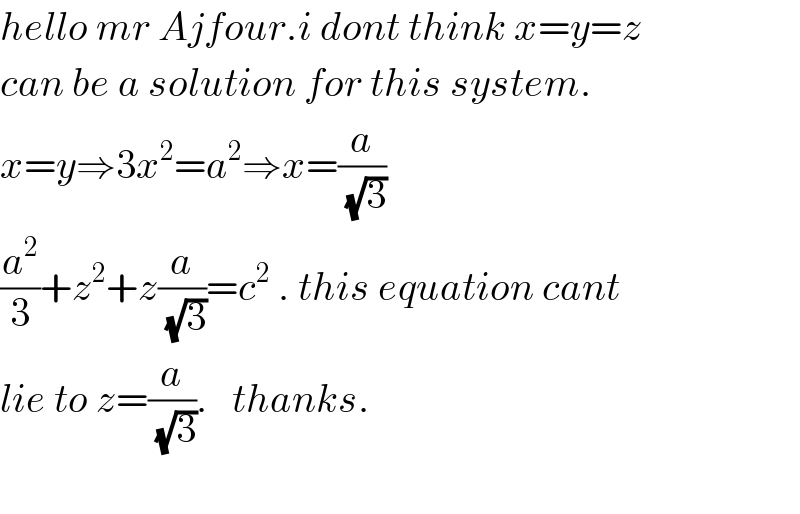
$${hello}\:{mr}\:{Ajfour}.{i}\:{dont}\:{think}\:{x}={y}={z} \\ $$$${can}\:{be}\:{a}\:{solution}\:{for}\:{this}\:{system}. \\ $$$${x}={y}\Rightarrow\mathrm{3}{x}^{\mathrm{2}} ={a}^{\mathrm{2}} \Rightarrow{x}=\frac{{a}}{\sqrt{\mathrm{3}}} \\ $$$$\frac{{a}^{\mathrm{2}} }{\mathrm{3}}+{z}^{\mathrm{2}} +{z}\frac{{a}}{\sqrt{\mathrm{3}}}={c}^{\mathrm{2}} \:.\:{this}\:{equation}\:{cant}\: \\ $$$${lie}\:{to}\:{z}=\frac{{a}}{\sqrt{\mathrm{3}}}.\:\:\:{thanks}. \\ $$$$ \\ $$
Commented by b.e.h.i.8.3.4.1.7@gmail.com last updated on 29/May/17

$${thanks}\:{dear}\:{mr}\:{Rasheed}.{your}\:{try}\:{is} \\ $$$${so}\:{beautiful}.{thank}\:{you}\:{and}\:{other}\: \\ $$$${my}\:{best}\:{friends}\:{in}\:{this}\:{forum}. \\ $$$${god}\:{bless}\:{you}\:{all}. \\ $$$${after}\:{all}\:{words},....\:{there}\:{is}\:{some}\:{days}\:{that}\:{mrW}\mathrm{1}, \\ $$$${is}\:{absent}.{i}\:{hope}\:{he}\:{is}\:{in}\:{safe}\:{and}\:{health}. \\ $$$$ \\ $$
Commented by mrW1 last updated on 29/May/17

$${Thank}\:{you}\:{dear}\:{friend}\:{for}\:{your}\:{care}!\: \\ $$$${Every}\:{thing}\:{is}\:{ok}\:{with}\:{me}. \\ $$
Commented by prakash jain last updated on 29/May/17

$$\mathrm{I}\:\mathrm{added}\:\mathrm{a}\:\mathrm{new}\:\mathrm{question}\:\mathrm{14211} \\ $$$$\mathrm{with}\:\mathrm{numbers}\:\mathrm{for}\:{a}^{\mathrm{2}} ,{b}^{\mathrm{2}} ,{c}^{\mathrm{2}} . \\ $$$$\mathrm{The}\:\mathrm{method}\:\mathrm{gives}\:\mathrm{the}\:\mathrm{result}\:\mathrm{but} \\ $$$$\mathrm{but}\:\mathrm{calculators}\:\mathrm{needed}. \\ $$
Commented by mrW1 last updated on 30/May/17
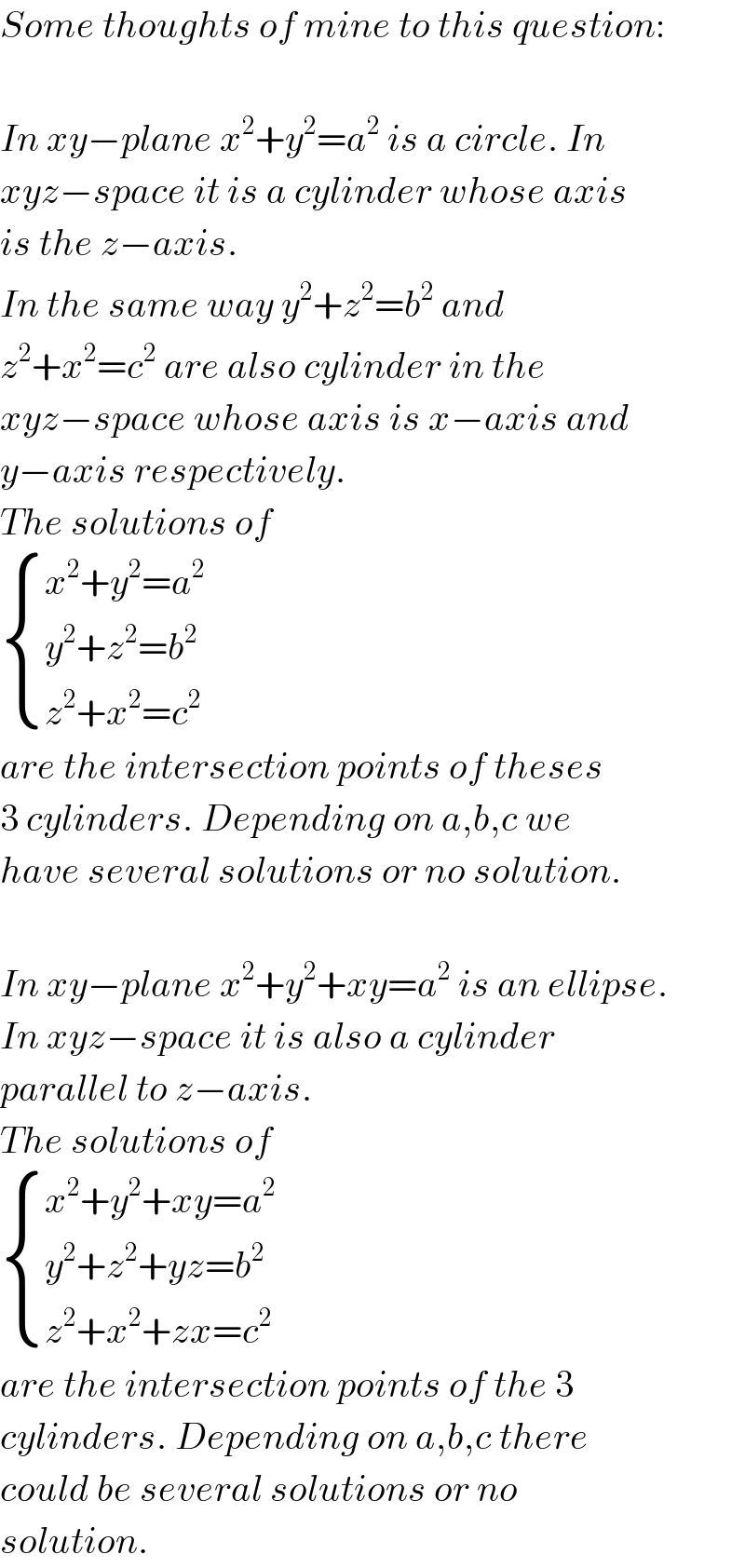
$${Some}\:{thoughts}\:{of}\:{mine}\:{to}\:{this}\:{question}: \\ $$$$ \\ $$$${In}\:{xy}−{plane}\:{x}^{\mathrm{2}} +{y}^{\mathrm{2}} ={a}^{\mathrm{2}} \:{is}\:{a}\:{circle}.\:{In} \\ $$$${xyz}−{space}\:{it}\:{is}\:{a}\:{cylinder}\:{whose}\:{axis} \\ $$$${is}\:{the}\:{z}−{axis}. \\ $$$${In}\:{the}\:{same}\:{way}\:{y}^{\mathrm{2}} +{z}^{\mathrm{2}} ={b}^{\mathrm{2}} \:{and}\: \\ $$$${z}^{\mathrm{2}} +{x}^{\mathrm{2}} ={c}^{\mathrm{2}} \:{are}\:{also}\:{cylinder}\:{in}\:{the} \\ $$$${xyz}−{space}\:{whose}\:{axis}\:{is}\:{x}−{axis}\:{and} \\ $$$${y}−{axis}\:{respectively}. \\ $$$${The}\:{solutions}\:{of}\: \\ $$$$\begin{cases}{{x}^{\mathrm{2}} +{y}^{\mathrm{2}} ={a}^{\mathrm{2}} }\\{{y}^{\mathrm{2}} +{z}^{\mathrm{2}} ={b}^{\mathrm{2}} }\\{{z}^{\mathrm{2}} +{x}^{\mathrm{2}} ={c}^{\mathrm{2}} }\end{cases} \\ $$$${are}\:{the}\:{intersection}\:{points}\:{of}\:{theses} \\ $$$$\mathrm{3}\:{cylinders}.\:{Depending}\:{on}\:{a},{b},{c}\:{we} \\ $$$${have}\:{several}\:{solutions}\:{or}\:{no}\:{solution}. \\ $$$$ \\ $$$${In}\:{xy}−{plane}\:{x}^{\mathrm{2}} +{y}^{\mathrm{2}} +{xy}={a}^{\mathrm{2}} \:{is}\:{an}\:{ellipse}. \\ $$$${In}\:{xyz}−{space}\:{it}\:{is}\:{also}\:{a}\:{cylinder} \\ $$$${parallel}\:{to}\:{z}−{axis}. \\ $$$${The}\:{solutions}\:{of} \\ $$$$\begin{cases}{{x}^{\mathrm{2}} +{y}^{\mathrm{2}} +{xy}={a}^{\mathrm{2}} }\\{{y}^{\mathrm{2}} +{z}^{\mathrm{2}} +{yz}={b}^{\mathrm{2}} }\\{{z}^{\mathrm{2}} +{x}^{\mathrm{2}} +{zx}={c}^{\mathrm{2}} }\end{cases} \\ $$$${are}\:{the}\:{intersection}\:{points}\:{of}\:{the}\:\mathrm{3} \\ $$$${cylinders}.\:{Depending}\:{on}\:{a},{b},{c}\:{there} \\ $$$${could}\:{be}\:{several}\:{solutions}\:{or}\:{no} \\ $$$${solution}. \\ $$
Commented by mrW1 last updated on 30/May/17

Commented by mrW1 last updated on 30/May/17

Commented by b.e.h.i.8.3.4.1.7@gmail.com last updated on 30/May/17

$${thank}\:{you}\:\:{dear}\:{mrW}\mathrm{1}.{it}\:{is}\:{a}\:{nice}\: \\ $$$${method},{if}\:{it}\:{give}\:{us}\:{some}\:{answers}. \\ $$
Commented by RasheedSindhi last updated on 30/May/17

$$\mathrm{G}^{\overset{\frown} {\mathcal{O}}\:\overset{\frown} {\mathcal{O}}} \mathrm{D}\:\:\mathrm{analysis}\:\mathrm{mrW1}! \\ $$
Commented by prakash jain last updated on 30/May/17

$$\mathrm{if}\:{a}={b}={c}\:\mathrm{then}\:{x}={y}={z} \\ $$$${x}={y}={z}=\frac{{a}}{\sqrt{\mathrm{3}}} \\ $$
Answered by b.e.h.i.8.3.4.1.7@gmail.com last updated on 31/May/17

$${we}\:{can}\:{assume}\:{that}:\:{x},{y},{z}\:{are}\:{segments} \\ $$$${in}\:{triangle}\:{ABC},{whit}\:{sides}\:{of}:{a},{b},{c} \\ $$$${such}\:{that}:\angle{ADB}=\angle{BDC}=\angle{CDA}=\mathrm{120}^{\bullet} . \\ $$$${now}\:{we}\:{have}:\:\left({see}\:{picture}\:{below}\Downarrow\right) \\ $$$${x}^{\mathrm{2}} +{y}^{\mathrm{2}} +{xy}={a}^{\mathrm{2}} \\ $$$${y}^{\mathrm{2}} +{z}^{\mathrm{2}} +{yz}={b}^{\mathrm{2}} \\ $$$${z}^{\mathrm{2}} +{x}^{\mathrm{2}} +{xz}={c}^{\mathrm{2}} \\ $$$${S}=\frac{\mathrm{1}}{\mathrm{2}}{xysin}\mathrm{120}+\frac{\mathrm{1}}{\mathrm{2}}{yzsin}\mathrm{120}+\frac{\mathrm{1}}{\mathrm{2}}{xzsin}\mathrm{120}= \\ $$$$=\frac{\sqrt{\mathrm{3}}}{\mathrm{4}}\left({xy}+{yz}+{xz}\right)\Rightarrow{xy}+{yz}+{zx}=\frac{\mathrm{4}{S}}{\sqrt{\mathrm{3}}} \\ $$$$\mathrm{2}\Sigma{x}^{\mathrm{2}} +\Sigma{xy}=\Sigma{a}^{\mathrm{2}} \Rightarrow\mathrm{2}\Sigma{x}^{\mathrm{2}} =\Sigma{a}^{\mathrm{2}} −\frac{\mathrm{4}{S}}{\sqrt{\mathrm{3}}} \\ $$$$\Rightarrow\Sigma{x}^{\mathrm{2}} =\Sigma\frac{{a}^{\mathrm{2}} }{\mathrm{2}}−\frac{\mathrm{2}{S}}{\sqrt{\mathrm{3}}} \\ $$$$\left(\Sigma{x}\right)^{\mathrm{2}} =\Sigma{x}^{\mathrm{2}} +\mathrm{2}\Sigma{xy}=\Sigma\frac{{a}^{\mathrm{2}} }{\mathrm{2}}−\frac{\mathrm{2}{S}}{\sqrt{\mathrm{3}}}+\mathrm{2}\left(\frac{\mathrm{4}{S}}{\sqrt{\mathrm{3}}}\right)= \\ $$$$=\Sigma\frac{{a}^{\mathrm{2}} }{\mathrm{2}}+\frac{\mathrm{6}{S}}{\sqrt{\mathrm{3}}}=\Sigma\frac{{a}^{\mathrm{2}} }{\mathrm{2}}+\mathrm{2}\sqrt{\mathrm{3}}{S} \\ $$$$\Rightarrow{x}+{y}+{z}=\sqrt{\Sigma\frac{{a}^{\mathrm{2}} }{\mathrm{2}}+\mathrm{2}\sqrt{\mathrm{3}}{S}}\:\:\left(={m}\right) \\ $$$$\mathrm{4}{S}=\sqrt{\left({a}+{b}+{c}\right)\left({a}+{b}−{c}\right)\left({a}+{c}−{b}\right)\left({b}+{c}−{a}\right)} \\ $$$$\left({x}−{z}\right)\left({x}+{y}+{z}\right)={a}^{\mathrm{2}} −{b}^{\mathrm{2}} \Rightarrow{x}−{z}=\frac{{a}^{\mathrm{2}} −{b}^{\mathrm{2}} }{{m}} \\ $$$$\left({y}−{x}\right)\left({x}+{y}+{z}\right)={b}^{\mathrm{2}} −{c}^{\mathrm{2}} \Rightarrow{y}−{x}=\frac{{b}^{\mathrm{2}} −{c}^{\mathrm{2}} }{{m}} \\ $$$$\Rightarrow\left({y}−{x}\right)−\left({x}−{z}\right)=\frac{\mathrm{2}{b}^{\mathrm{2}} −\left({a}^{\mathrm{2}} +{c}^{\mathrm{2}} \right)}{{m}}\Rightarrow \\ $$$$\Rightarrow{m}−\mathrm{3}{x}=\frac{\mathrm{2}{b}^{\mathrm{2}} −\left({a}^{\mathrm{2}} +{c}^{\mathrm{2}} \right)}{{m}}\Rightarrow \\ $$$${x}=\frac{{m}^{\mathrm{2}} +{a}^{\mathrm{2}} +{c}^{\mathrm{2}} −\mathrm{2}{b}^{\mathrm{2}} }{\mathrm{3}{m}} \\ $$$${m}^{\mathrm{2}} +{a}^{\mathrm{2}} +{c}^{\mathrm{2}} −\mathrm{2}{b}^{\mathrm{2}} =\Sigma\frac{{a}^{\mathrm{2}} }{\mathrm{2}}+\mathrm{2}\sqrt{\mathrm{3}}{S}+{a}^{\mathrm{2}} +{c}^{\mathrm{2}} −\mathrm{2}{b}^{\mathrm{2}} = \\ $$$$=\frac{\mathrm{1}}{\mathrm{2}}\left(\mathrm{3}{a}^{\mathrm{2}} +\mathrm{3}{c}^{\mathrm{2}} −\mathrm{3}{b}^{\mathrm{2}} +\mathrm{4}\sqrt{\mathrm{3}}{S}\right) \\ $$$$\Rightarrow{x}=\frac{\sqrt{\mathrm{3}}}{\mathrm{2}}.\frac{\mathrm{4}{S}+\sqrt{\mathrm{3}}\left({a}^{\mathrm{2}} +{c}^{\mathrm{2}} −{b}^{\mathrm{2}} \right)}{\mathrm{3}{m}} \\ $$$${x}=\frac{\mathrm{1}}{\sqrt{\mathrm{6}}}.\frac{\sqrt{\left({a}+{b}+{c}\right)\left({a}+{b}−{c}\right)\left({a}+{c}−{b}\right)\left({b}+{c}−{a}\right)}+\sqrt{\mathrm{3}}\left({a}^{\mathrm{2}} +{c}^{\mathrm{2}} −{b}^{\mathrm{2}} \right)}{\sqrt{{a}^{\mathrm{2}} +{b}^{\mathrm{2}} +{c}^{\mathrm{2}} +\sqrt{\mathrm{3}\left({a}+{b}+{c}\right)\left({a}+{b}−{c}\right)\left({a}+{c}−{b}\right)\left({b}+{c}−{a}\right)}}} \\ $$$${x}−{z}=\frac{{a}^{\mathrm{2}} −{b}^{\mathrm{2}} }{{m}},{y}−{z}=\frac{{a}^{\mathrm{2}} −{c}^{\mathrm{2}} }{{m}} \\ $$$$\Rightarrow{m}−\mathrm{3}{z}=\frac{\mathrm{2}{a}^{\mathrm{2}} −\left({b}^{\mathrm{2}} +{c}^{\mathrm{2}} \right)}{{m}}\Rightarrow{z}=\frac{{m}^{\mathrm{2}} +{b}^{\mathrm{2}} +{c}^{\mathrm{2}} −\mathrm{2}{a}^{\mathrm{2}} }{\mathrm{3}{m}} \\ $$$${m}^{\mathrm{2}} +{b}^{\mathrm{2}} +{c}^{\mathrm{2}} −\mathrm{2}{a}^{\mathrm{2}} =\Sigma\frac{{a}^{\mathrm{2}} }{\mathrm{2}}+\mathrm{2}\sqrt{\mathrm{3}}{S}+{b}^{\mathrm{2}} +{c}^{\mathrm{2}} −\mathrm{2}{a}^{\mathrm{2}} = \\ $$$$=\frac{\mathrm{1}}{\mathrm{2}}\left(\mathrm{3}{b}^{\mathrm{2}} +\mathrm{3}{c}^{\mathrm{2}} −\mathrm{3}{a}^{\mathrm{2}} +\mathrm{4}\sqrt{\mathrm{3}}{S}\right) \\ $$$$\Rightarrow{z}=\frac{\sqrt{\mathrm{3}}}{\mathrm{2}}.\frac{\mathrm{4}{S}+\sqrt{\mathrm{3}}\left({b}^{\mathrm{2}} +{c}^{\mathrm{2}} −{a}^{\mathrm{2}} \right)}{\mathrm{3}{m}} \\ $$$$\Rightarrow\boldsymbol{{z}}=\frac{\mathrm{1}}{\sqrt{\mathrm{6}}}.\frac{\sqrt{\left(\boldsymbol{{a}}+\boldsymbol{{b}}+\boldsymbol{{c}}\right)\left(\boldsymbol{{a}}+\boldsymbol{{b}}−\boldsymbol{{c}}\right)\left(\boldsymbol{{a}}+\boldsymbol{{c}}−\boldsymbol{{b}}\right)\left(\boldsymbol{{b}}+\boldsymbol{{c}}−\boldsymbol{{a}}\right)}+\sqrt{\mathrm{3}}\left(\boldsymbol{{b}}^{\mathrm{2}} +\boldsymbol{{c}}^{\mathrm{2}} −\boldsymbol{{a}}^{\mathrm{2}} \right)}{\sqrt{\boldsymbol{{a}}^{\mathrm{2}} +\boldsymbol{{b}}^{\mathrm{2}} +\boldsymbol{{c}}^{\mathrm{2}} +\sqrt{\mathrm{3}\left(\boldsymbol{{a}}+\boldsymbol{{b}}+\boldsymbol{{c}}\right)\left(\boldsymbol{{a}}+\boldsymbol{{b}}−\boldsymbol{{c}}\right)\left(\boldsymbol{{a}}+\boldsymbol{{c}}−\boldsymbol{{b}}\right)\left(\boldsymbol{{b}}+\boldsymbol{{c}}−\boldsymbol{{a}}\right)}}} \\ $$$$\boldsymbol{{y}}=\boldsymbol{{m}}−\left(\boldsymbol{{x}}+\boldsymbol{{z}}\right)=\boldsymbol{{m}}−\frac{{m}^{\mathrm{2}} +{a}^{\mathrm{2}} +{c}^{\mathrm{2}} −\mathrm{2}{b}^{\mathrm{2}} }{\mathrm{3}{m}}−\frac{{m}^{\mathrm{2}} +{b}^{\mathrm{2}} +{c}^{\mathrm{2}} −\mathrm{2}{a}^{\mathrm{2}} }{\mathrm{3}{m}}= \\ $$$$=\frac{\mathrm{3}{m}^{\mathrm{2}} −{m}^{\mathrm{2}} −{a}^{\mathrm{2}} −{c}^{\mathrm{2}} +\mathrm{2}{b}^{\mathrm{2}} −{m}^{\mathrm{2}} −{b}^{\mathrm{2}} −{c}^{\mathrm{2}} +\mathrm{2}{a}^{\mathrm{2}} }{\mathrm{3}{m}}= \\ $$$$\Rightarrow{y}=\frac{{m}^{\mathrm{2}} +{a}^{\mathrm{2}} +{b}^{\mathrm{2}} −\mathrm{2}{c}^{\mathrm{2}} }{\mathrm{3}{m}} \\ $$$${m}^{\mathrm{2}} +{a}^{\mathrm{2}} +{b}^{\mathrm{2}} −\mathrm{2}{c}^{\mathrm{2}} =\frac{{a}^{\mathrm{2}} +{b}^{\mathrm{2}} +{c}^{\mathrm{2}} }{\mathrm{2}}+\mathrm{2}\sqrt{\mathrm{3}}{S}+{a}^{\mathrm{2}} +{b}^{\mathrm{2}} −\mathrm{2}{c}^{\mathrm{2}} = \\ $$$$=\frac{\mathrm{1}}{\mathrm{2}}\left(\mathrm{3}{a}^{\mathrm{2}} +\mathrm{3}{b}^{\mathrm{2}} −\mathrm{3}{c}^{\mathrm{2}} +\mathrm{4}\sqrt{\mathrm{3}}{S}\right) \\ $$$$\Rightarrow{y}=\frac{\sqrt{\mathrm{3}}}{\mathrm{2}}.\frac{\mathrm{4}{S}+\sqrt{\mathrm{3}}\left({a}^{\mathrm{2}} +{b}^{\mathrm{2}} −{c}^{\mathrm{2}} \right)}{\mathrm{3}{m}} \\ $$$$\Rightarrow\boldsymbol{{y}}=\frac{\mathrm{1}}{\sqrt{\mathrm{6}}}.\frac{\sqrt{\left(\boldsymbol{{a}}+\boldsymbol{{b}}+\boldsymbol{{c}}\right)\left(\boldsymbol{{a}}+\boldsymbol{{b}}−\boldsymbol{{c}}\right)\left(\boldsymbol{{a}}+\boldsymbol{{c}}−\boldsymbol{{b}}\right)\left(\boldsymbol{{b}}+\boldsymbol{{c}}−\boldsymbol{{a}}\right)}+\sqrt{\mathrm{3}}\left(\boldsymbol{{a}}^{\mathrm{2}} +\boldsymbol{{b}}^{\mathrm{2}} −\mathrm{2}\boldsymbol{{c}}^{\mathrm{2}} \right)}{\sqrt{\boldsymbol{{a}}^{\mathrm{2}} +\boldsymbol{{b}}^{\mathrm{2}} +\boldsymbol{{c}}^{\mathrm{2}} +\sqrt{\mathrm{3}\left(\boldsymbol{{a}}+\boldsymbol{{b}}+\boldsymbol{{c}}\right)\left(\boldsymbol{{a}}+\boldsymbol{{b}}−\boldsymbol{{c}}\right)\left(\boldsymbol{{a}}+\boldsymbol{{c}}−\boldsymbol{{b}}\right)\left(\boldsymbol{{b}}+\boldsymbol{{c}}−\boldsymbol{{a}}\right)}}}\:.\blacksquare \\ $$
Commented by b.e.h.i.8.3.4.1.7@gmail.com last updated on 30/May/17

Commented by b.e.h.i.8.3.4.1.7@gmail.com last updated on 31/May/17
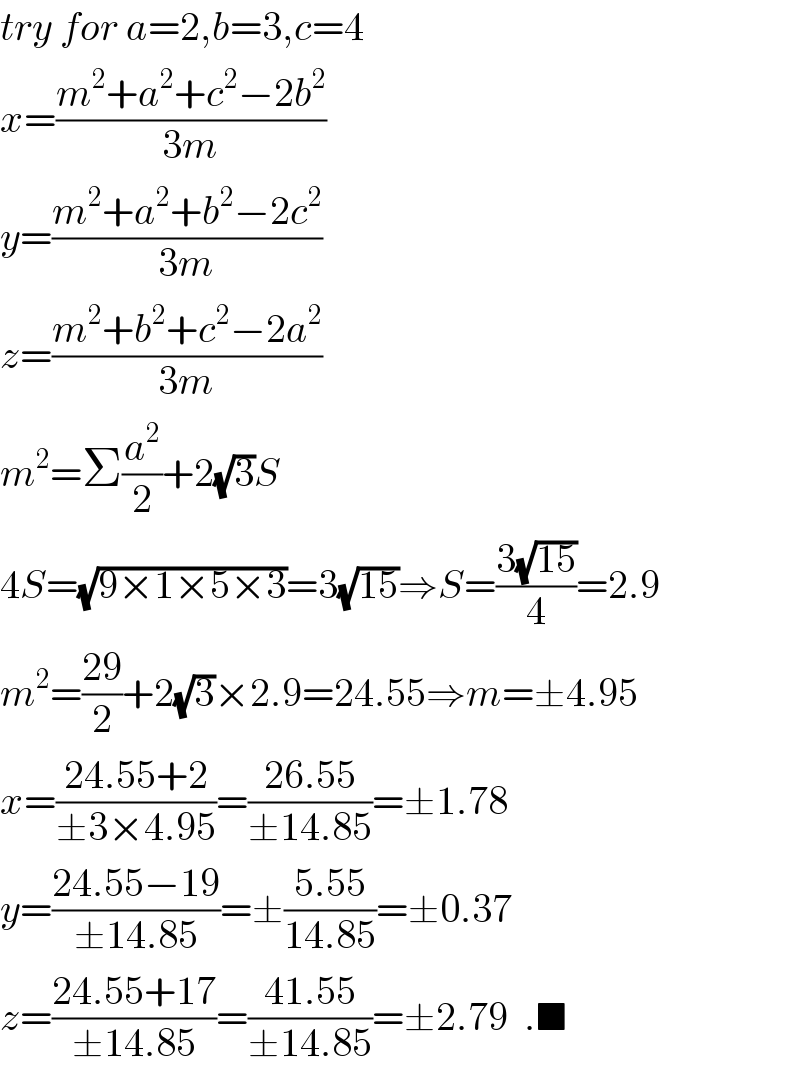
$${try}\:{for}\:{a}=\mathrm{2},{b}=\mathrm{3},{c}=\mathrm{4} \\ $$$${x}=\frac{{m}^{\mathrm{2}} +{a}^{\mathrm{2}} +{c}^{\mathrm{2}} −\mathrm{2}{b}^{\mathrm{2}} }{\mathrm{3}{m}} \\ $$$${y}=\frac{{m}^{\mathrm{2}} +{a}^{\mathrm{2}} +{b}^{\mathrm{2}} −\mathrm{2}{c}^{\mathrm{2}} }{\mathrm{3}{m}} \\ $$$${z}=\frac{{m}^{\mathrm{2}} +{b}^{\mathrm{2}} +{c}^{\mathrm{2}} −\mathrm{2}{a}^{\mathrm{2}} }{\mathrm{3}{m}} \\ $$$${m}^{\mathrm{2}} =\Sigma\frac{{a}^{\mathrm{2}} }{\mathrm{2}}+\mathrm{2}\sqrt{\mathrm{3}}{S} \\ $$$$\mathrm{4}{S}=\sqrt{\mathrm{9}×\mathrm{1}×\mathrm{5}×\mathrm{3}}=\mathrm{3}\sqrt{\mathrm{15}}\Rightarrow{S}=\frac{\mathrm{3}\sqrt{\mathrm{15}}}{\mathrm{4}}=\mathrm{2}.\mathrm{9} \\ $$$${m}^{\mathrm{2}} =\frac{\mathrm{29}}{\mathrm{2}}+\mathrm{2}\sqrt{\mathrm{3}}×\mathrm{2}.\mathrm{9}=\mathrm{24}.\mathrm{55}\Rightarrow{m}=\pm\mathrm{4}.\mathrm{95} \\ $$$${x}=\frac{\mathrm{24}.\mathrm{55}+\mathrm{2}}{\pm\mathrm{3}×\mathrm{4}.\mathrm{95}}=\frac{\mathrm{26}.\mathrm{55}}{\pm\mathrm{14}.\mathrm{85}}=\pm\mathrm{1}.\mathrm{78} \\ $$$${y}=\frac{\mathrm{24}.\mathrm{55}−\mathrm{19}}{\pm\mathrm{14}.\mathrm{85}}=\pm\frac{\mathrm{5}.\mathrm{55}}{\mathrm{14}.\mathrm{85}}=\pm\mathrm{0}.\mathrm{37} \\ $$$${z}=\frac{\mathrm{24}.\mathrm{55}+\mathrm{17}}{\pm\mathrm{14}.\mathrm{85}}=\frac{\mathrm{41}.\mathrm{55}}{\pm\mathrm{14}.\mathrm{85}}=\pm\mathrm{2}.\mathrm{79}\:\:.\blacksquare \\ $$
Commented by mrW1 last updated on 31/May/17

$${that}'{s}\:{perfect}! \\ $$
Commented by b.e.h.i.8.3.4.1.7@gmail.com last updated on 31/May/17
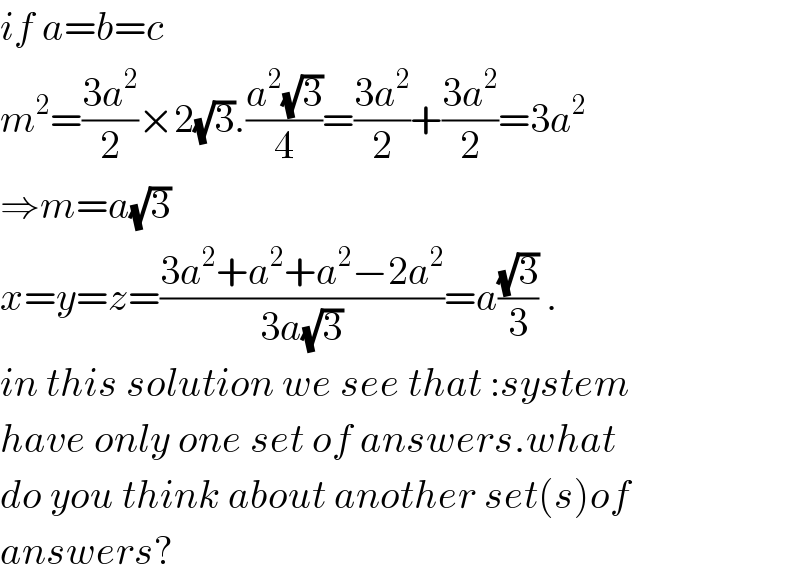
$${if}\:{a}={b}={c} \\ $$$${m}^{\mathrm{2}} =\frac{\mathrm{3}{a}^{\mathrm{2}} }{\mathrm{2}}×\mathrm{2}\sqrt{\mathrm{3}}.\frac{{a}^{\mathrm{2}} \sqrt{\mathrm{3}}}{\mathrm{4}}=\frac{\mathrm{3}{a}^{\mathrm{2}} }{\mathrm{2}}+\frac{\mathrm{3}{a}^{\mathrm{2}} }{\mathrm{2}}=\mathrm{3}{a}^{\mathrm{2}} \\ $$$$\Rightarrow{m}={a}\sqrt{\mathrm{3}} \\ $$$${x}={y}={z}=\frac{\mathrm{3}{a}^{\mathrm{2}} +{a}^{\mathrm{2}} +{a}^{\mathrm{2}} −\mathrm{2}{a}^{\mathrm{2}} }{\mathrm{3}{a}\sqrt{\mathrm{3}}}={a}\frac{\sqrt{\mathrm{3}}}{\mathrm{3}}\:. \\ $$$${in}\:{this}\:{solution}\:{we}\:{see}\:{that}\::{system} \\ $$$${have}\:{only}\:{one}\:{set}\:{of}\:{answers}.{what} \\ $$$${do}\:{you}\:{think}\:{about}\:{another}\:{set}\left({s}\right){of} \\ $$$${answers}? \\ $$
Commented by mrW1 last updated on 31/May/17
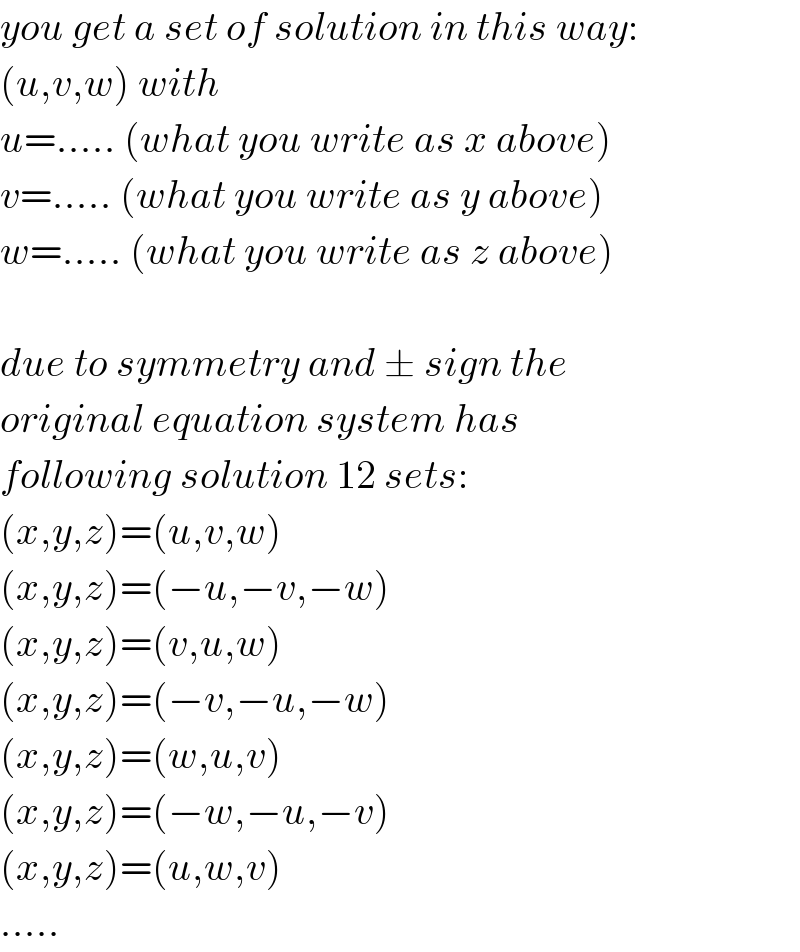
$${you}\:{get}\:{a}\:{set}\:{of}\:{solution}\:{in}\:{this}\:{way}: \\ $$$$\left({u},{v},{w}\right)\:{with} \\ $$$${u}=.....\:\left({what}\:{you}\:{write}\:{as}\:{x}\:{above}\right) \\ $$$${v}=.....\:\left({what}\:{you}\:{write}\:{as}\:{y}\:{above}\right) \\ $$$${w}=.....\:\left({what}\:{you}\:{write}\:{as}\:{z}\:{above}\right) \\ $$$$ \\ $$$${due}\:{to}\:{symmetry}\:{and}\:\pm\:{sign}\:{the} \\ $$$${original}\:{equation}\:{system}\:{has} \\ $$$${following}\:{solution}\:\mathrm{12}\:{sets}: \\ $$$$\left({x},{y},{z}\right)=\left({u},{v},{w}\right) \\ $$$$\left({x},{y},{z}\right)=\left(−{u},−{v},−{w}\right) \\ $$$$\left({x},{y},{z}\right)=\left({v},{u},{w}\right) \\ $$$$\left({x},{y},{z}\right)=\left(−{v},−{u},−{w}\right) \\ $$$$\left({x},{y},{z}\right)=\left({w},{u},{v}\right) \\ $$$$\left({x},{y},{z}\right)=\left(−{w},−{u},−{v}\right) \\ $$$$\left({x},{y},{z}\right)=\left({u},{w},{v}\right) \\ $$$$..... \\ $$
Commented by b.e.h.i.8.3.4.1.7@gmail.com last updated on 31/May/17

$${thank}\:{you}\:{dear}\:{mrW}\mathrm{1}.{you}\:{are}\:{right}. \\ $$$${what}\:{do}\:{you}\:{think}\:{about}\:\Uparrow{this}\:{solution}? \\ $$$${we}\:{use}\:{geometry}\:\:{to}\:{solve}, \\ $$$${and}\:{my}\:{be},\:{we}\:{lost}\:{some}\:{answers}\:. \\ $$
Commented by mrW1 last updated on 31/May/17
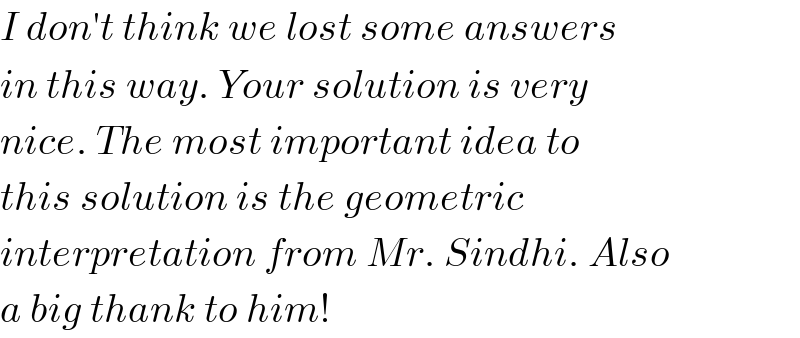
$${I}\:{don}'{t}\:{think}\:{we}\:{lost}\:{some}\:{answers} \\ $$$${in}\:{this}\:{way}.\:{Your}\:{solution}\:{is}\:{very} \\ $$$${nice}.\:{The}\:{most}\:{important}\:{idea}\:{to} \\ $$$${this}\:{solution}\:{is}\:{the}\:{geometric} \\ $$$${interpretation}\:{from}\:{Mr}.\:{Sindhi}.\:{Also} \\ $$$${a}\:{big}\:{thank}\:{to}\:{him}! \\ $$
Commented by b.e.h.i.8.3.4.1.7@gmail.com last updated on 31/May/17

$${thanks}\:{a}\:{lot}.{yes}\:.{mrW}\mathrm{1},{mr}\:{sindhi}, \\ $$$${mr}\:{prakash},{mr}\:{Ajfour},{all}\:{have}\:{the} \\ $$$${same}\:{part}\:{in}\:{solving}\:{this}\:{Q}. \\ $$$${i}\:{love}\:{you}\:{all}\:{my}\:{best}\:{friends}. \\ $$
Commented by RasheedSindhi last updated on 31/May/17

$$\mathcal{T}{hanks}\:{very}\:{much}\:{mrW}\mathrm{1}\:\mathrm{and} \\ $$$$\mathrm{behi}\:\mathrm{for}\:\mathrm{encouraging}/\mathrm{appreciating} \\ $$$$\mathrm{so}\:\mathrm{much}.\:\mathrm{I}\:\mathrm{also}\:\mathrm{love}\:\mathrm{the}\:\mathrm{answer} \\ $$$$\mathrm{of}\:\overset{?} {\mathrm{Mr}}/\overset{?} {\mathrm{Miss}}\:\mathrm{behi}! \\ $$
Commented by RasheedSindhi last updated on 31/May/17
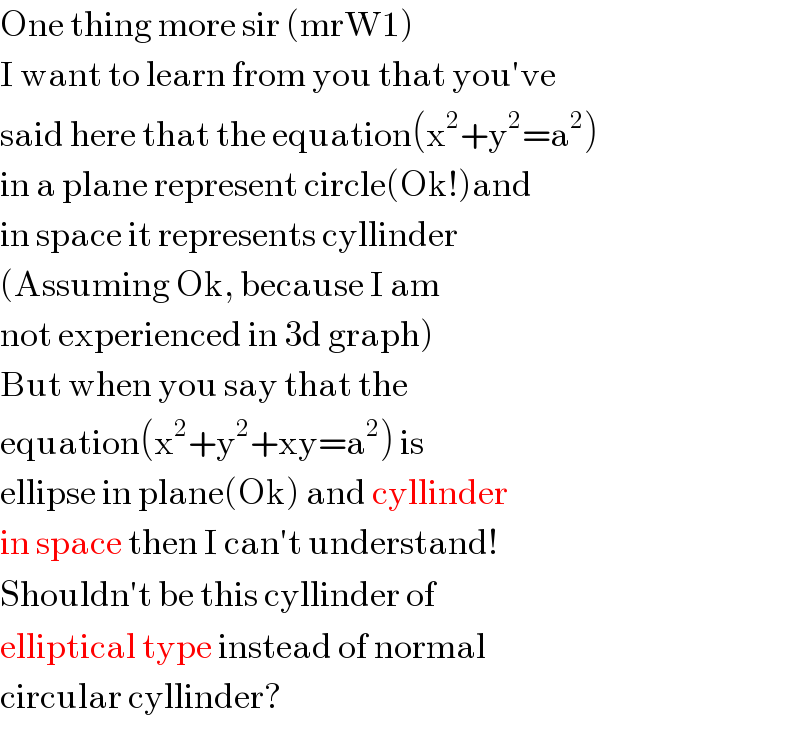
$$\mathrm{One}\:\mathrm{thing}\:\mathrm{more}\:\mathrm{sir}\:\left(\mathrm{mrW1}\right) \\ $$$$\mathrm{I}\:\mathrm{want}\:\mathrm{to}\:\mathrm{learn}\:\mathrm{from}\:\mathrm{you}\:\mathrm{that}\:\mathrm{you}'\mathrm{ve} \\ $$$$\mathrm{said}\:\mathrm{here}\:\mathrm{that}\:\mathrm{the}\:\mathrm{equation}\left(\mathrm{x}^{\mathrm{2}} +\mathrm{y}^{\mathrm{2}} =\mathrm{a}^{\mathrm{2}} \right) \\ $$$$\mathrm{in}\:\mathrm{a}\:\mathrm{plane}\:\mathrm{represent}\:\mathrm{circle}\left(\mathrm{Ok}!\right)\mathrm{and} \\ $$$$\mathrm{in}\:\mathrm{space}\:\mathrm{it}\:\mathrm{represents}\:\mathrm{cyllinder} \\ $$$$\left(\mathrm{Assuming}\:\mathrm{Ok},\:\mathrm{because}\:\mathrm{I}\:\mathrm{am}\right. \\ $$$$\left.\mathrm{not}\:\mathrm{experienced}\:\mathrm{in}\:\mathrm{3d}\:\mathrm{graph}\right) \\ $$$$\mathrm{But}\:\mathrm{when}\:\mathrm{you}\:\mathrm{say}\:\mathrm{that}\:\mathrm{the} \\ $$$$\mathrm{equation}\left(\mathrm{x}^{\mathrm{2}} +\mathrm{y}^{\mathrm{2}} +\mathrm{xy}=\mathrm{a}^{\mathrm{2}} \right)\:\mathrm{is} \\ $$$$\mathrm{ellipse}\:\mathrm{in}\:\mathrm{plane}\left(\mathrm{Ok}\right)\:\mathrm{and}\:\mathrm{cyllinder} \\ $$$$\mathrm{in}\:\mathrm{space}\:\mathrm{then}\:\mathrm{I}\:\mathrm{can}'\mathrm{t}\:\mathrm{understand}! \\ $$$$\mathrm{Shouldn}'\mathrm{t}\:\mathrm{be}\:\mathrm{this}\:\mathrm{cyllinder}\:\mathrm{of} \\ $$$$\mathrm{elliptical}\:\mathrm{type}\:\mathrm{instead}\:\mathrm{of}\:\mathrm{normal} \\ $$$$\mathrm{circular}\:\mathrm{cyllinder}? \\ $$
Commented by mrW1 last updated on 31/May/17

$${Yes}.\:{It}\:{is}\:{an}\:{oval}\:{cylinder}. \\ $$
Commented by RasheedSindhi last updated on 31/May/17

$$\mathcal{T}{hanks}! \\ $$
Commented by b.e.h.i.8.3.4.1.7@gmail.com last updated on 31/May/17

$${mr}\:{Rasheed}!\:{i}\:{am}\:{your}\:{first}\:{quistion} \\ $$$${mark}!\left({hahaha}\right)\:{thanks}. \\ $$
Commented by RasheedSindhi last updated on 31/May/17
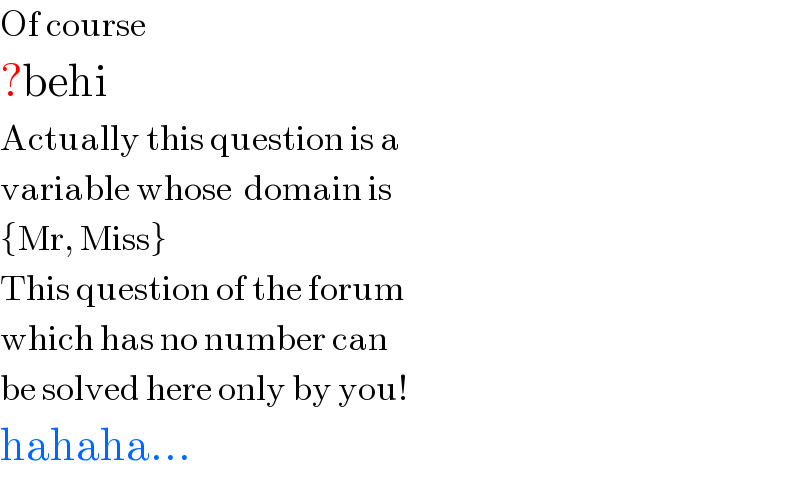
$$\mathrm{Of}\:\mathrm{course} \\ $$$$?\mathrm{behi} \\ $$$$\mathrm{Actually}\:\mathrm{this}\:\mathrm{question}\:\mathrm{is}\:\mathrm{a} \\ $$$$\mathrm{variable}\:\mathrm{whose}\:\:\mathrm{domain}\:\mathrm{is} \\ $$$$\left\{\mathrm{Mr},\:\mathrm{Miss}\right\} \\ $$$$\mathrm{This}\:\mathrm{question}\:\mathrm{of}\:\mathrm{the}\:\mathrm{forum} \\ $$$$\mathrm{which}\:\mathrm{has}\:\mathrm{no}\:\mathrm{number}\:\mathrm{can}\: \\ $$$$\mathrm{be}\:\mathrm{solved}\:\mathrm{here}\:\mathrm{only}\:\mathrm{by}\:\mathrm{you}! \\ $$$$\mathrm{hahaha}... \\ $$
Commented by RasheedSindhi last updated on 31/May/17

$$\mathrm{If}\:\mathrm{you}\:\mathrm{solve}\:\mathrm{then}\:\mathrm{in}\:\mathrm{Miss}\:\mathrm{tawa}'\mathrm{s} \\ $$$$\mathrm{words}: \\ $$$$\mathrm{God}\:\mathrm{bless}\:\mathrm{you}\:\boldsymbol{\mathrm{sir}}!\:\mathrm{I}\:\mathrm{really}\:\mathrm{appreciate}\:\mathrm{you}. \\ $$
Commented by b.e.h.i.8.3.4.1.7@gmail.com last updated on 31/May/17
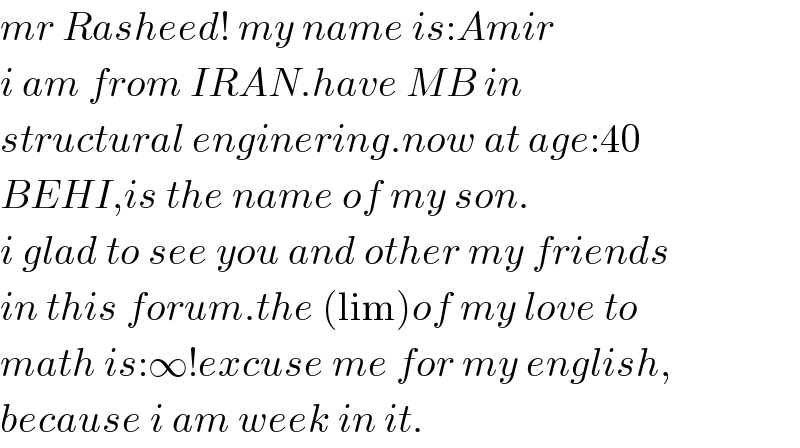
$${mr}\:{Rasheed}!\:{my}\:{name}\:{is}:{Amir} \\ $$$${i}\:{am}\:{from}\:{IRAN}.{have}\:{MB}\:{in} \\ $$$${structural}\:{enginering}.{now}\:{at}\:{age}:\mathrm{40} \\ $$$${BEHI},{is}\:{the}\:{name}\:{of}\:{my}\:{son}. \\ $$$${i}\:{glad}\:{to}\:{see}\:{you}\:{and}\:{other}\:{my}\:{friends} \\ $$$${in}\:{this}\:{forum}.{the}\:\left(\mathrm{lim}\right){of}\:{my}\:{love}\:{to} \\ $$$${math}\:{is}:\infty!{excuse}\:{me}\:{for}\:{my}\:{english}, \\ $$$${because}\:{i}\:{am}\:{week}\:{in}\:{it}. \\ $$
Commented by RasheedSindhi last updated on 01/Jun/17

$$\mathcal{HAPPY}\:\:{to}\:{be}\:{introduced}\:{with} \\ $$$${you}!\:\mathcal{I}\:'{m}\:{from}\:{Sindh},\:{Pakistan}. \\ $$$$\mathcal{I}\:'{m}\:{maths}\:{teacher}\:{in}\:{a}\:{high} \\ $$$${school}.\:\mathcal{I}\:{also}\:{love}\:{maths}\:{and} \\ $$$${that}'{s}\:{the}\:{reason}\:{of}\:{my}\:{being} \\ $$$${in}\:{this}\:{fine}\:{forum}! \\ $$$$\mathcal{I}\:{learnt}\:{much}\:{from}\:{forum}-{friends} \\ $$$${and}\:{want}\:{to}\:{learn}\:{much}\:{more}! \\ $$
